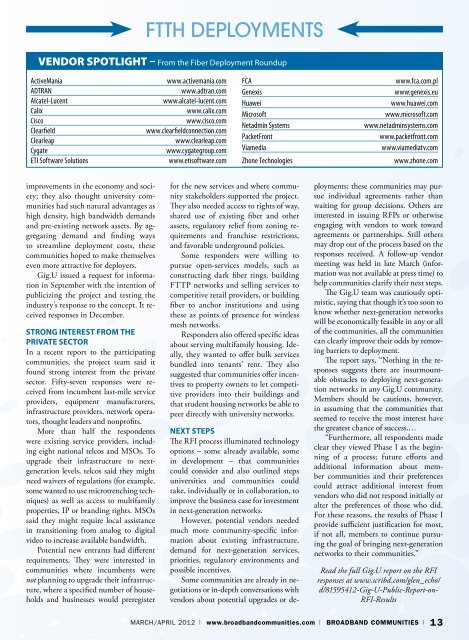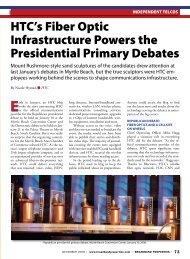March/April - Broadband Communities Magazine
March/April - Broadband Communities Magazine
March/April - Broadband Communities Magazine
You also want an ePaper? Increase the reach of your titles
YUMPU automatically turns print PDFs into web optimized ePapers that Google loves.
FTTH deploymenTs<br />
VeNDor SpotlIGHt – From the Fiber Deployment Roundup<br />
ActiveMania www.activemania.com<br />
ADTRAN www.adtran.com<br />
Alcatel-Lucent www.alcatel-lucent.com<br />
Calix www.calix.com<br />
Cisco www.cisco.com<br />
Clearfield www.clearfieldconnection.com<br />
Clearleap www.clearleap.com<br />
Cygate www.cygategroup.com<br />
ETI Software Solutions www.etisoftware.com<br />
improvements in the economy and society;<br />
they also thought university communities<br />
had such natural advantages as<br />
high density, high bandwidth demands<br />
and pre-existing network assets. By aggregating<br />
demand and finding ways<br />
to streamline deployment costs, these<br />
communities hoped to make themselves<br />
even more attractive for deployers.<br />
Gig.U issued a request for information<br />
in September with the intention of<br />
publicizing the project and testing the<br />
industry’s response to the concept. It received<br />
responses in December.<br />
sTroNG INTeresT FroM THe<br />
prIVaTe seCTor<br />
In a recent report to the participating<br />
communities, the project team said it<br />
found strong interest from the private<br />
sector. Fifty-seven responses were received<br />
from incumbent last-mile service<br />
providers, equipment manufacturers,<br />
infrastructure providers, network operators,<br />
thought leaders and nonprofits.<br />
More than half the respondents<br />
were existing service providers, including<br />
eight national telcos and MSOs. To<br />
upgrade their infrastructure to nextgeneration<br />
levels, telcos said they might<br />
need waivers of regulations (for example,<br />
some wanted to use microtrenching techniques)<br />
as well as access to multifamily<br />
properties, IP or branding rights. MSOs<br />
said they might require local assistance<br />
in transitioning from analog to digital<br />
video to increase available bandwidth.<br />
Potential new entrants had different<br />
requirements. They were interested in<br />
communities where incumbents were<br />
not planning to upgrade their infrastructure,<br />
where a specified number of households<br />
and businesses would preregister<br />
for the new services and where community<br />
stakeholders supported the project.<br />
They also needed access to rights of way,<br />
shared use of existing fiber and other<br />
assets, regulatory relief from zoning requirements<br />
and franchise restrictions,<br />
and favorable underground policies.<br />
Some responders were willing to<br />
pursue open-services models, such as<br />
constructing dark fiber rings, building<br />
FTTP networks and selling services to<br />
competitive retail providers, or building<br />
fiber to anchor institutions and using<br />
these as points of presence for wireless<br />
mesh networks.<br />
Responders also offered specific ideas<br />
about serving multifamily housing. Ideally,<br />
they wanted to offer bulk services<br />
bundled into tenants’ rent. They also<br />
suggested that communities offer incentives<br />
to property owners to let competitive<br />
providers into their buildings and<br />
that student housing networks be able to<br />
peer directly with university networks.<br />
NexT sTeps<br />
The RFI process illuminated technology<br />
options – some already available, some<br />
in development – that communities<br />
could consider and also outlined steps<br />
universities and communities could<br />
take, individually or in collaboration, to<br />
improve the business case for investment<br />
in next-generation networks.<br />
However, potential vendors needed<br />
much more community-specific information<br />
about existing infrastructure,<br />
demand for next-generation services,<br />
priorities, regulatory environments and<br />
possible incentives.<br />
Some communities are already in negotiations<br />
or in-depth conversations with<br />
vendors about potential upgrades or de-<br />
FCA www.fca.com.pl<br />
Genexis www.genexis.eu<br />
Huawei www.huawei.com<br />
Microsoft www.microsoft.com<br />
Netadmin Systems www.netadminsystems.com<br />
PacketFront www.packetfront.com<br />
Viamedia www.viamediatv.com<br />
Zhone Technologies www.zhone.com<br />
ployments; these communities may pursue<br />
individual agreements rather than<br />
waiting for group decisions. Others are<br />
interested in issuing RFPs or otherwise<br />
engaging with vendors to work toward<br />
agreements or partnerships. Still others<br />
may drop out of the process based on the<br />
responses received. A follow-up vendor<br />
meeting was held in late <strong>March</strong> (information<br />
was not available at press time) to<br />
help communities clarify their next steps.<br />
The Gig.U team was cautiously optimistic,<br />
saying that though it’s too soon to<br />
know whether next-generation networks<br />
will be economically feasible in any or all<br />
of the communities, all the communities<br />
can clearly improve their odds by removing<br />
barriers to deployment.<br />
The report says, “Nothing in the responses<br />
suggests there are insurmountable<br />
obstacles to deploying next-generation<br />
networks in any Gig.U community.<br />
Members should be cautious, however,<br />
in assuming that the communities that<br />
seemed to receive the most interest have<br />
the greatest chance of success.…<br />
“Furthermore, all respondents made<br />
clear they viewed Phase I as the beginning<br />
of a process; future efforts and<br />
additional information about member<br />
communities and their preferences<br />
could attract additional interest from<br />
vendors who did not respond initially or<br />
alter the preferences of those who did.<br />
For these reasons, the results of Phase I<br />
provide sufficient justification for most,<br />
if not all, members to continue pursuing<br />
the goal of bringing next-generation<br />
networks to their communities.”<br />
Read the full Gig.U report on the RFI<br />
responses at www.scribd.com/glen_echo/<br />
d/81595412-Gig-U-Public-Report-on-<br />
RFI-Results<br />
<strong>March</strong>/april 2012 | www.broadbandcommunities.com | BROADBAND COMMUNITIES | 13



